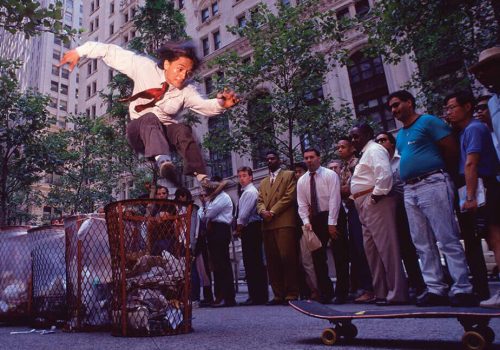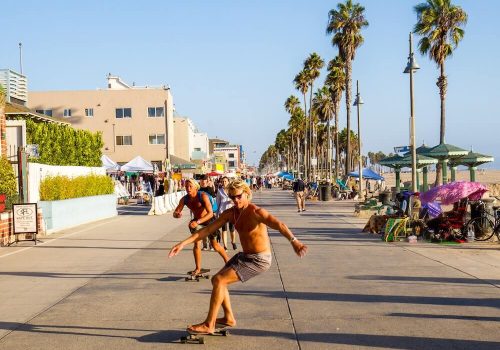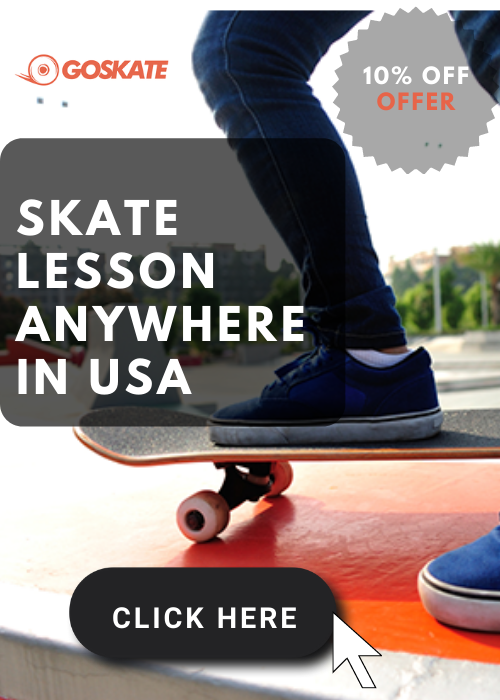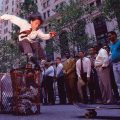Wait, shouldn’t we be teaching you how to not fall on a skateboard?
Technically, we are since learning how to fall on a skateboard is an integral part of learning how to skateboard. Literally, as every skater will tell you, falling is a part of skateboarding and actually is a sign of progress, not a sign of failure.
That is precisely why learning how to fall on a skateboard is so important and is even considered an art form and skill in itself. While it can be scary to know you’re going to fall when learning how to skate, just know you’re not alone.
Every skater, beginner or pro, has to deal with the fear of falling. It’s what makes landing a new trick so rewarding in the first place. It’s also what builds confidence and self development for youngsters learning how to skate.
All that being said, we’ve compiled some of the most proven tips from our students, instructors and pro skaters to give you a complete guide on how to not only fall the safest way possible, but the most productive way possible.
In this article we’ll be going over:
- Safety Precautions to Avoid Injury
- Different Types of Skateboard Falls
- Tips on How to Fall on a Skateboard
If you’ve recently experienced an injury or would like to prevent future injuries, we invite you to watch our YouTube video explaining how to rehab and prevent skateboarding injuries.
Safety Precautions to Avoid Injury
The easiest way to take safety precautions to avoid injury it to wear protective gear and skateboarding pads such as:
- knee pads
- wrist guards
- elbow pads
- helmet
Your shoes and clothes are also a form of safety gear. Proper skate shoes with durability materials and slip-resistant soles are best for combating grip tape scrapes and the ground of skateparks.
You can find proper protective gear at your local skate shop – including skate shoes. We also offer a complete skateboard package with full pads and a completely assembled skateboard ready for beginners.
Properly warming up is also one of the key ingredients to avoiding injury. The older you are the more stretching you will have to do but all skaters should be properly warmed up to avoid skateboard injuries or serious injury. Take some time to cruise around the skatepark or the flat surface you are skating on. Once you have a decent sweat going and feel ‘warm’ enough to move quickly in response to a skate fall, you’re properly warmed up.
Different Types of Skateboard Falls

For the beginner skater, all falls might seem equal. But in reality, there are different types of skateboarding falls, some of which are more productive than others while some can lead to potentially serious injury.
Bail: “The bail” is arguably the most productive type of skateboard fall, as the term bail means you chose to kick away your board or essentially chose not to attempt to land the trick. The only reason why it might not be the most productive fall, is because you generally want to commit to a trick, as that is the only way you’re going to land it. But the learning process means you have to give yourself room to make mistakes and actually learn the trick. So if you’re trying to kickflip that 8 stair for the first time, you might bail a few times to get comfortable. That’s why learning to fall is also so important.
Stuck It: “Did you land it?” One skater asks his friend, “No, but I stuck it.” This is a conversation you might hear at the skatepark between two skaters talking about landing a new trick. You remember watching Tony Hawk try the 900? He kept landing on his board but not riding away. This is to signify that the skater committed to the trick and even landed with both feet on the board. This is the closest you can come to almost landing a trick. It generally does not result in injury as committing to a trick almost always works out better than not committing.
Slam: The word slam is probably the only word in skateboarding you don’t want to hear as it is most associated with skateboarding injuries and serious injury or even severe injury. The word slam is derived from the nature of the fall, which generally the skater had no idea the fall was coming and could do nothing to prevent the fall. Imagine the skater was trying to boardslide their first handrail. They bailed out a few times before eventually almost landing one after they stuck it a few times. They have all the confidence to fully commit but one of their attempts they go over the rail and their board doesn’t. What results is a slam and hopefully no serious injury thanks to the proper safety gear and learning how to fall on a skateboard.
Tips on How to Fall on a Skateboard

While there might not exist a real tutorial on how to fall on a skateboard, there are generally tips you can follow to not only fall with less injury, but more productively.
If you’re a beginner skateboarder or a seasoned pro, here are some tips specifically for you:
Skate Flat Surfaces: When our students are first learning how to skateboard, we always encourage them to master the flat surfaces before attempting the transition aspects of local skateparks. Trying to drop in on a ramp before you’re ready is one of the easiest ways to end up with a serious injury. So if you haven’t mastered skating flat surfaces, you’re increasing your chances of falling in the future.
Learn over your Front Foot: In skateboarding, it can feel counterintuitive to lean over your front foot when normally we like to stand up straight. While eventually you’ll gain confidence in being more straight on your skateboard, at first it’s a better strategy to stay slightly over your front foot. Not only does this ensure you fall forward, since you take your back foot off to pedal/push on a skateboard, it helps combat the poor balance new skaters tend to have.
Falling Forward: We touched briefly but falling forward is always better than falling backward. The number one reason is really to protect your arms and wrists from sparing or a more severe injury, but also because falling forward is a sign that you are committing to your trick. Falling forward also helps you fall on your shoulders or slide out on your hips with better balance than if you landed sideways or even backwards. It also matches the momentum of you skating which is also a good sign you’re going in the right direction, (literally).
Skate in a Safe Environment: Skating in a safe environment doesn’t just mean skating at your local skatepark. If you haven’t mastered the foundations of skating the skatepark might not actually be a safe environment for you yet. The traffic of skaters is a potential hazard and can result in collisions. That being said, even a local parking lot with no skaters or cars can be less than safe. Always check the ground for large cracks, pebbles, rough surfaces, spills, oil, or anything that could jeopardize your balance.
Lower your Center of Gravity: Someone telling you to lower your center of gravity might sound like something out of a martial arts movie, well skateboarding and martial arts have a lot in common. Your center of gravity is generally right below your naval, the part of your board that connects the bottom half to the top half of your body. In most instances, crouching and lowering your center of gravity not only reduces the risk of falling but if you do fall greatly reduces the chances of slamming. Think of the difference between throwing a ball on the ground than a plank of wood. Rolling, sliding, etc., are always better than a hard tumble.
Learn to Roll: Rolling is how pro skaters get out of some pretty serious skate predicaments. Skaters are a lot like cats, we always fall on our feet, well at first, then we have to do something about all that momentum. The pros are going to roll over their shoulder or their hips to spread that momentum out laterally instead of a complete downward slam.

Learn how to Slide: The same is exactly true for learning how to slide. The idea is the same, taking that forward momentum and instead of pile driving it into the ground, after you hit the ground first with your feet, you extend your body outward to slide on the ground, You do not do this with your wrists however, instead you do so with your shoulders, elbows and hips. This is why skaters have a tremendous amount of scrapes and scars on their elbows and often have holes in their pants and t-shirts.
Avoid Hill Bombing: The number one reasons a skater will end up in the hospital or sustain a severe even fatal injury is hill bombing. What is hill bombing? Well skating down the biggest, steepest, hill you can find. We recommend only professional skaters do this as it simply is just not worth it. It doesn’t have to even be that big of a hill, just one you know you’re not ready for. Be safe and have fun! That’s the GOSKATE motto.
Check the Obstacle: Checking the obstacle for debris is one thing but there’s also the possibility someone waxed the ledge or rail without you knowing which can result in you a slam or a serious injury. Take your trucks or your nose or tail and test the slide and grind of an obstacle. Before you drop in a ramp, look for any debris, trash or pebbles that could result in you losing your balance.
Don’t Skate with Headphones: You might go to the skatepark and see more experienced skaters skating with headphones. But for the beginner skater it’s generally not a good idea to skate with headphones as your chances for collision are much higher. Also if you’re in someone’s way you might not hear them. Maybe one day you can skate with headphones, but you should be extremely comfortable skating at a skatepark before attempting to do so.
Don’t Skate Alone: Skating with a friend is always safer and usually a lot more fun. It’s great to have someone there to watch your back or call for help if you get injured. Call up some friends to hit the local skatepark or ask your parents or guardian to take you to an empty parking lot to skate. If you don’t have any local skaters, feel free to hire a GOSKATE instructor to not only teach you how to skateboard but be a local mentor in the skate world.
Don’t Let Someone Pressure You: The other side of not skating alone is to also not allow anyone to pressure you into something you’re not ready for. This can especially be true for younger skaters at the skatepark of varying skill. Remember, there’s no coach, there’s no one in charge of you but you when it comes to skating. If your friend drops in before you, so what. Whoever is having the most fun is the best skater.
Hire a GOSKATE Instructor: Like we said earlier, there is nothing more productive than hiring a GOSKATE instructor when it comes to learning how to skateboard. Not only in learning how to fall on a skateboard but learning how to skateboard in general. Heading to the skatepark with a GOSKATE instructor will also teach you or your loved one about proper skatepark etiquette and what it means to be a skateboarder; aspects of skateboarding that normally take years to learn.
Always Get Back Up: You hear a lot about what skateboarding can teach you and arguably nothing is more significant than the idea of getting back up after you fall. After all, you arguably fall more than you land when you skate. That’s the whole point. We take an idea of a kickflip in our heads, something we have no idea how to do, and we figure it out. On the way, we might fall. But we always get back up. That’s what makes skateboarding so amazing and what makes skateboarders some of the rarest people on the planet.











![How to Skateboard with your Dog [Best Breeds]](https://www.goskate.com/top/wp-content/uploads/2022/01/Screen-Shot-2022-02-10-at-12.54.16-e1644490564854-80x80.png)


